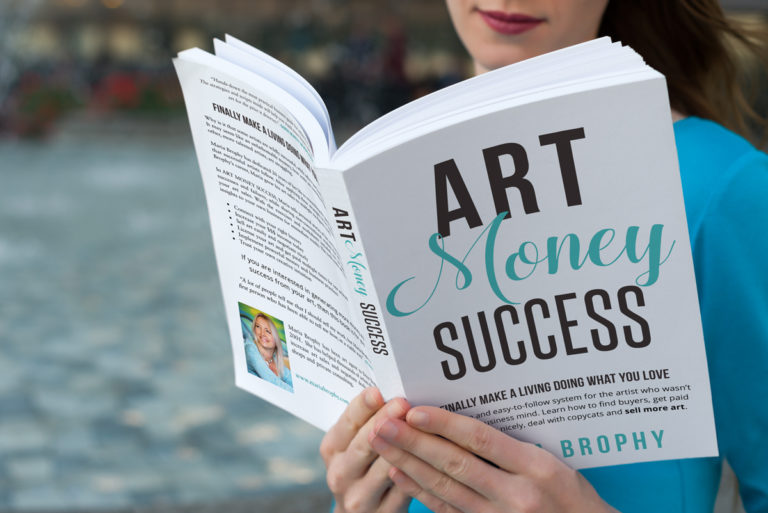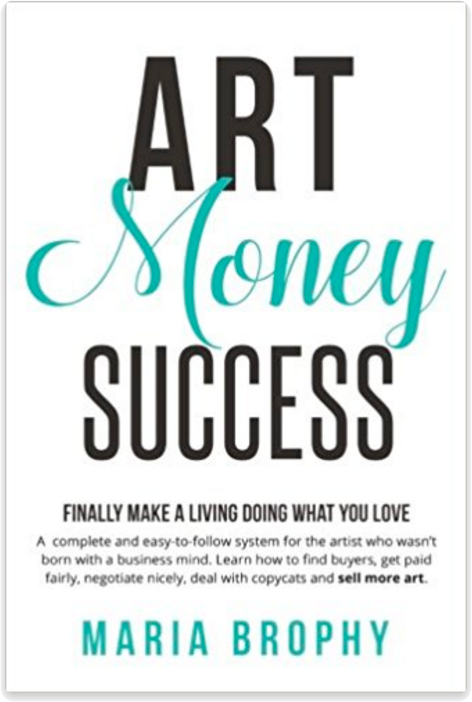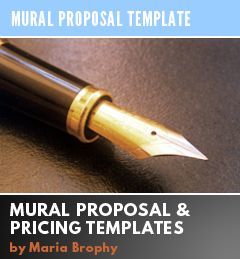An artist wrote for help with pricing. She said “it’s rare for a buyer to accept my proposal outright.”
She explained that every time she is asked to give a price quote, her buyers attempt to talk her down in price. She is starting to feel bitter towards her buyers, and angry that they don’t appreciate her value.
This is a common problem, especially for artists who are new to business. Please know that you can solve this, because once you understand where the buyer’s hesitation comes from, you can remedy it. (I discuss this and other solutions to problems with selling art in my book in great detail.)
But first, know that there are two issues going on inside our own minds, when a buyer wants to negotiate down on price:
1 – The first issue is our erroneous belief that it is our buyer’s fault that they don’t see our value.
2 – The second issue is our erroneous belief that selling our art should happen easily and naturally.
For the first : It is not your buyer’s fault if they don’t understand your value or don’t know that your prices are non-negotiable.
Their understanding of “how you work” is entirely your responsibility.
You may be creating an invitation to negotiate your prices. Artists do this all the time, unknowingly. Here’s a few examples:
I.) You imply that your price is negotiable by a lack of confidence in your voice when you give a quote, through the words that you use or through your body language. Your buyer will pick up on this.
REMEDY: Practice feeling confident giving a price quote. Allow your words to sound like you’ve quoted it a hundred times before, and that your prices are set. Then, use your body language to show that you are confident – stand tall, arms back, head high. This makes a difference to people who feel unworthy of their own pricing. Body language transmits to our brains and makes us feel the way our body is standing.
and:
Create a standardized pricing system. Does it make sense on paper, how you price for one size versus another size, or one type of service versus another? Having a standard pricing structure will help you give prices in a confident manner, and it will make your buyers feel more confident about your prices as well.
II.) You haven’t taken the time to explain or show the buyer that you are fully capable of giving them what they want.
Remedy: Take the time to sell your art and services to your buyer.
What I mean is this: don’t give up on your buyers when they question your pricing or your skill. Take the time to help them to understand how you work, and give them other options if they have a smaller budget. And, show similar works that you have done for other buyers, to help them see what you are capable of.
III.) You are charging more than your mastery commands
I once hired a graphic designer to do work for me. He charged me top prices, which I happily paid, but in the end, his work wasn’t good enough for me to even use. I lost the money I paid him. I realized that some people are over-charging for their skill set.
Make sure that you are charging in accordance with your experience and what you have to offer. If you aren’t, then you may be attracting buyers who sense this and don’t want to pay your prices.
On the other hand, if you are the top in your field, or if you have many years of experience, or a long line of happy buyers, then charge your higher prices accordingly. If someone cannot or will not pay those prices, then they are not your target market.
IV) You are charging more than this particular market will pay
Sometimes I see artists exhibit at shows where the middle class attend, but their art is priced for the more affluent. You won’t sell affluent pricing at middle class venues.
If you are selling on Etsy, a lower end market, you wouldn’t charge Saatchi prices. If you want to charge higher prices, you have to target affluent buyers, and this means that you have to go to where affluent buyers hang out.
HOW TO WIN IN NEGOTIATING:
The best way to win the negotiating game is to avoid it in the first place and make it clear that your prices are what they are. They are not negotiable.
You can make it clear in your communications. When you give a price, give it confidently. During conversation, you can mention different options, based on size or substrate or complexity, etc.
When someone calls for a price quote for a custom shaped and painted surfboard, I tell them “pricing depends on size and complexity of the design. It ranges from $2,500 – $10,000. But the most commonly ordered piece is $4,500.”
By saying it in this way, they get an idea of the price range and that our most commonly sold item is priced at $4,500. They also understand that we have done many, many custom painted surfboards, because of the way I responded. If they cannot afford it, it is at this stage that they realize that it’s out of their price range, and I’m okay with the fact that not everyone can pay our prices. Those that can pay it, do.
Take the time to give your buyer confidence in your abilities. I always say that a buyer’s budget is equal to the amount of confidence they have in your ability to give them what they want.
Take the time to show them or tell them about other projects you’ve done in the past. Explain your process, your materials and anything else that is relevant that shows the value in what you do.
Tell the buyer about a similar project you have done for another buyer who was wildly happy with the results. You can describe a previous happy buyer and your process in this way: “When I created XXX for a collector who asked for XXX, my approach was XXX…..and they were extremely happy with the end result.”
This could be a little easier if you let your website do most of this work for you. It could show excellent photos and have descriptions of what you’ve done in the past.
For our corporate clients, we have created “Case Studies” on Drew’s site to show how we have worked with large name clients to solve their marketing problems, with art. These case studies have worked hard for us, as they clearly demonstrate the value of what we offer. The added benefit is the key words that are in the case studies, which bring people to our site through Google that are looking for similar art and services.
When a viable buyer is confident that you can do what they need, they are more than happy to pay full price.
Many artists will GIVE UP on their buyers the second the buyer questions pricing.
DON’T GIVE UP ON YOUR BUYER! Not until after you have exhausted all options.
A few years ago I quoted a painting project at $4,000. After giving the quote, the buyer said he only had a budget of $2,500. My first reaction was disappointment, I assumed that we just wouldn’t close that gap, as it was too large. I almost gave up, but then decided to see if I could work it out with him. I took the time to explain to the buyer the work involved. I showed him how Drew was going to do what he needed him to do in this project. In the end, we worked it out and he increased his budget. I learned a huge lesson that day; to not give up on the buyer until after I did all I could to help them understand the process and value of what they wanted.
Even if it seems all hope is lost to salvage the sale, do this: Decide to have fun with it; experiment and try out different methods of communicating with your buyer and see if any of them work.
WHEN A BUYER ASKS FOR A LOWER PRICE, DO THIS:
Don’t you hate it when a buyer says “Oh, I really want this, but I only have half of what you’re asking.”
If a buyer is pushing for a lower price, either convince them to raise their budget to get what they really want, or, offer them a lower priced option.
For example, if the buyer says they can only afford $800 but they want your $1,500 item, say this: “Okay, so instead of paying $1,500, you would like an $800 option? Well, I can do this. We can cut back on my time by making the project more simple, using less expensive materials and a smaller size. So here is what I can do for $800….”
NEVER give the same option for a lower price. If you do, your buyer will never trust your prices again. And you will feel bad about yourself. It’s bad business all the way around.
Always offer a lower option for a lower price.
And if all else fails, and the buyer still doesn’t want to pay you what’s reasonable, don’t take it personally. They just aren’t the right buyer for you; they are not in alignment with your offerings.
Instead of feeling bad about it, refer them to an artist who is either in high school or college, trying to build their portfolio. By doing this, you are being gracious, and at the same time, making it clear to them that if they want to pay low prices they have to go to someone who is not experienced. You get what you pay for. It’s an important lesson for everyone.
Have you experienced this? Having a buyer talk to you down on price? And if so, how have you handled it? Share in the comments, please!
Maria xxoo











18 Responses
Thank you, Maria. This was really informative. It is so helpful to get real language to use in responses and approaches. Most don’t go this far.
Ask buyer what they do for a living. If buyer says “I am an attorney” then say ” Great I need help getting out of these parking tickets. What do you charge an hour?” Attorney says “250/hr” then say “great how about you handle my case for “$100./hour?”
Hey, Maria! I consulted with you several years ago, before embarking on my business, and you were not only very encouraging but you gave me some great first steps. I tried to keep up with your blog, and your articles on pricing have been invaluable. My most recent mural project ….with children for a school, has had it’s ups and downs, but the phrase I learned from you has keep me on top of every curve ball. “This is how I work”….. I had set out an initial contract that I referred back to and am sticking to it. Thank you so much for your practical wisdom learned through experience. I soooooo appreciate it !
Carol, thank you for this! It feels good knowing that you have adopted my “this is how I work” mantra! It truly is a life changer in the art biz. Thanks for keeping in touch 🙂
Absolutely “spot-on” for dealing with objections. My wife & I not only run a Sign Business together (our backgrounds are very diverse, collectively, but mainly come from the Outdoor Industry known as Billboards. She, an accomplished designer & me, a Master Painter Journeyman). We currently do everything in this Industry except for neon. She does all of the computer work & does some pictorial work, I do airbrushing, pinstriping & pictorial work, as well as, master lettering. We constantly run into budgetary issues not only in our Sign Business but also in our Mural Business which we’re trying to completely switch over to. Our favorite response to “How much will this cost?” is this: “More than a six-pack but less than a mortgage” ~ this always breaks the ice & segways into an enjoyable conversation about pricing. We can sometimes “sell up” by being humorous & trustworthy, all the while explaining what we can & can’t do.
One of my mentors once said, wisely “You don’t want to get every job. If you do, you’re doing something wrong!”
I’ve lived carefully by this advice. One more thing; when my wife & I ever have a bad feeling about a potential client & we don’t agree, we ALWAYS yield to the one who has the bad feeling, no matter how bad the other wants the job. We’ve vowed to live by this because we were burned in the past & we don’t care to visit that place ever again because WE are in control of who we work for & we don’t HAVE to be taken when we already yield to the warning signs.
Hope this helps someone.
Wow, Brad, so much wisdom in this comment you wrote! I especially love these 2 tidbits:
“More than a six-pack but less than a mortgage”
and
“You don’t want to get every job. If you do, you’re doing something wrong.”
I’m adding these two nuggets to my tool kit!
I can’t wait to put these methods to work– although, as a grad student in the rural-ish Southeast, opportunities are still pretty limited. However, I did gain confidence from your chapter on live events, and a week later, I stuck my neck out & got a live painting gig for a fundraiser!
Thank you for another great article, Maria!
For me, publishing a clear and straight-forward pricing schedule was one of the best moves I ever made. It weeds out the lower end market so I don’t waste my valuable time and energy writing bids and attempting to sell my work to people who can’t afford to hire me anyway. And when people do receive my bid, they understand that there was a clear and logical method of arriving at the price.
I also will employ the tactic of offering various options at different price points when the client is price-sensitive. This is a great way to successfully make a sale for someone you want to work with but who is unable or unwilling to pay your regular pricing. Occasionally the client will even end up picking the more expensive option after being given several options at varying price points. By allowing the client to choose the level of features or detail they want to pay for, this gives them a sense of control over the process. And sometimes this perceived level of control is all the client actually needs in order to feel good about moving forward with hiring you.
Cheers,
Morgan Bricca
Morgan Mural Studios
https://www.morganmurals.com
In regards to negotiation of artwork, I have included a percentage in the prices of the art in my gallery. Do you think this is a good idea or should I hold stedfast on my prices?
Thank you for this excellent advice! I wish i’d read this in school!
Tahnks for this excellent advice! I just wish I’d read this back in school!
I just finished a large project. My client and I had gone back and forth for three months before she finally signed the contract. Once we were finished and she was ecstatic about the result, I asked her why she had chosen me over the other muralist she had considered. Her response surprised me. Even though she had a fixed budget to work with and the other muralist and I had quoted her about the same price, she said she chose me because every time she had an objection or concern, I came back with options while the other muralist simply restated the price. Thanks for the great advice!
I have a customer who wanted to pay $40.00 perhaps less for a painting . I suggested options like a same size canvas for a lower price. The customer accepte it & in the end I choose a smaller size canvas for her & cave her a price which the customer accepted.
I would like to ask a question. Is $250.00 too much for a 12′ x 20′ x 1.1/2 ” deep canvas?
Phillip, thanks for the question. It think $250 is a low price for a canvas print of that size. Many artists charge .70 cents or more per square inch, and your price is a lot less than that. Good job on how you handled your buyer. Customers rely on us to help them figure out how to get what they want at the price they can pay. This doesn’t mean off-pricing your work, but instead, offering something that costs less, that will still make them happy. Sounds like that’s what you did!
I watched a video about pricing paintings and the message was that every artist should charge a minimum of $2 per square inch. If every artist applied this concept, the idea of starving artists would be greatly reduced.
Maria,
Thinks so much for this blog subject, sooooo very helpful!!
I recently sold a painting that has been for sale for over a year. I do not have prices on my smaller pieces so when buyers ask about it I could offer a better price if I wanted to move the piece quickly. But just as you state, body language and confidence is everything. I recently decided that if I don’t get the price I want I need to stay firm, like it’s no big deal if the buyers buys it or not, I believe they pick up on my confidences that it will sell. A potential buyer asked about the piece and then the price. With confidences I told her the full price I eas asking for. I was firm, loud and strong. SOld!! I picked up on this right away, as the piece was well done, had a lot of time and soul put into, but it was a little different from the other pieces I have sold. When other customers had asked about the piece I was not as bold and confident giving the answer and quickly realized I was doing myself a disfavour.
The article you wrote about valuing our work, which really means valuing ourselves, is excellent. It reaffirmed what I have come to learn myself and some!
I wonder if you have a similar article on commissions?
Last year I was commissioned to paint a cat. It was a a small piece 8”x10” I had been doing a few commissions in watercolour and for that size charging $100. Please keep in mind that I am a hobby painter.
The buyer sent me two photos and told me the one her daughter liked best, who the painting was for, but understood that an artist had a better eye for which photo of the cat would make a better painting. I picked the one that was not the favourite as it had way more character. The watercolour was not working at all so I scrapped it and did oil. Turn out fabulous! When I sent a photo of the painting the buyer wrote me to say it was beautiful, but the wrong picture. When I mentioned that she gave me the choice, she did not recall saying that. Not wanting to disappoint her I frantically painted the other picture in oil and she was thrilled. She asked what I would do with the first one, I know she was hoping I was giving to her. She was very surprised when I told her I would sell it. I also made it clear that because I did not negotiate an oil painting price she was getting this one at a deal and that normally it would be $200. I wasn’t sure how to work the money, and chalked it up to a big lesson for me. I secretly hoped she would understand and pay me more, but nope, I received the $100 and she received the one oil painting.
I find commissions the most difficult. Especially when it’s a subject I have not painted before. And then there is always the fear of the buyer not liking it. Then what? I have a customer asking for a large piece about 3’x4’ do I ask for a deposit? And if the buyer doesn’t like it in the end keep the deposit? It can be complex. I know this buyer well, she is fussy and I know that if she didn’t like it she would ask to put the deposit towards a new painting.
Great advice, Maria! As usual. 🙂 My partner is the artist, and I am the manager, in a similar fashion as you and Drew, except we’re in our infancy. We’re located in Nova Scotia, in the country, 1.5 hours from our capital city, and our art is priced a little over what a typical buyer can afford. When a buyer asks how much a piece is and it’s above their budget, we offer a payment plan. It’s a great way to overcome the ‘I can’t afford that’ response from a potential buyer. They don’t actually get to take the piece home until it is completely paid for. It’s a wee bit of management on my end, yet it a huge even the goal we desire…to create collectors, and make it easier for current collectors to purchase more to add to their collection.
I’m interested to know your take on this.
Much love, and all the very best, favour and fortune to you and yours!
XXOO
As always, excellent article!
I’ve had a lot more success with clients agreeing to my prices now that I offer an installment plan with Afterpay. It has even helped with clients who were originally hesitant, to actually increase their budget and go for a larger size because they’ll be paying over time with no interest. Another bonus is that I receive the funds immediately and it’s just between the bank and my client to handle the details.
Thanks for all your great tips, Maria!